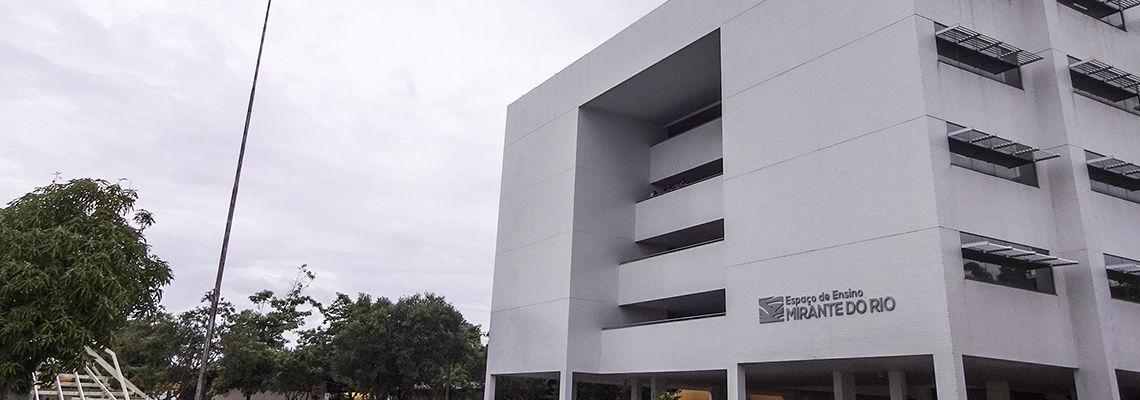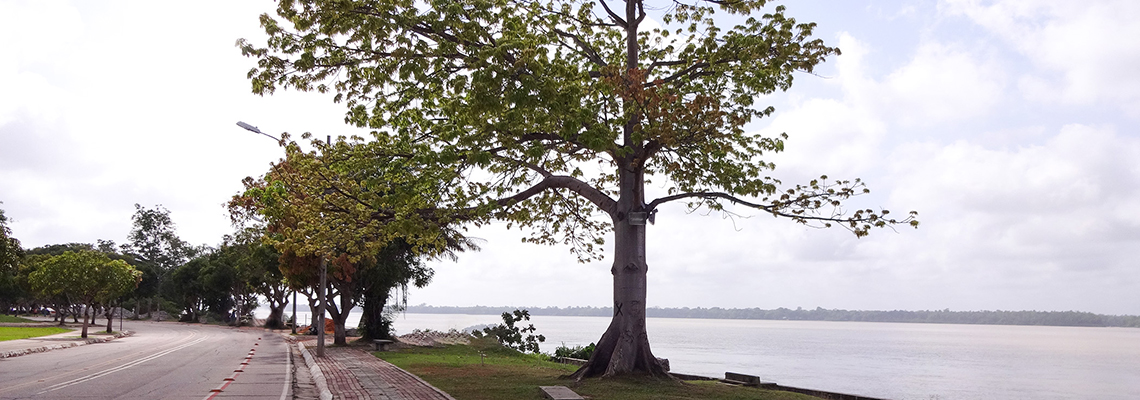Laboratory of Environmental and Human (NMT-UFPA)
Coordinated by Professor Maria da Conceição Pinheiro, this laboratory works in the areas of characterization of toxic effects, particularly heavy metals, with emphasis on mercury, the environment and human health. It has three different types of Mercury Analyzers of the Atomic Absorption Spectrophotometry type (one SP-3D, Nippon, one HG 201 and one Varian). A Shimatsu Gas Chromatograph for methylmercury analysis. Two chapels of exhaustion. Analytical balances. Two centrifuges. Split. Nobreak.
Laboratory of Biostatistics and Computational Mathematics (NMT-UFPA)
Coordinated by Professor Anderson Raiol Rodrigues, aims to carry out studies that involve the analysis of data in medical-biological investigations, through the use of computational and biostatistical methods.
Laboratory of Molecular and Cellular Biology (IEC-MS)
This laboratory works in the areas of molecular epidemiology using molecular genetic methods to characterize etiological agents, identification of host susceptibility markers for infectious and parasitic diseases. It is coordinated by Professors Edna Aoba Ishikawa and Maisa Souza. Equipment: thermocyclers, -70 degrees freezer, -20 degrees freezer, refrigerators, precision scale, ELISA reader, electrophoresis source, horizontal electrophoresis trough, vertical electrophoresis trough, binocular optical microscope, fluorescence microscope, non-refrigerated microcentrifuge, refrigerated microcentrifuge, centrifuge, laminar flow hood, exhaust hood, water bath, stove, autoclave, water purifier, water distiller, transilluminator, microwave.
Laboratory of Cytopathology
Diagnosis, prevention and study of gynecological cancer and diagnosis of sexually transmitted diseases.
Laboratory of Clinical and Epidemiology of Endemic Diseases (UFPA-NMT-ICB)
Coordinated by Professor Luisa Carício Martins, it works in the areas of diagnosis and study of tropical infectious diseases and emerging and re-emerging diseases of regional interest, such as schistosomiasis, intestinal parasites, malaria, mycoses and leprosy.
Laboratory of Dermato-Immunology Dr. Marcelo Cândia (UEPA-UFPA-IEC-SESPA)
Coordinated by Professor Claudio Salgado, the 200-square-meter LDI is located within the old Marituba leprosy colony in the Belém metropolitan area. The LDI has two 2-meter long laminar flow chapels (Pachane 340, Brazil); two CO2 greenhouses (GS laboratory equipments, USA); a 15/50 ml Falcon tube centrifuge with electronic timer (Nova Técnica, Brazil); a refrigerated microcentrifuge for eppendorfs (14000 DR, Nova Técnica, Brazil); a non-refrigerated eppendorf centrifuge (Eppendorf, USA); five refrigerators 4 / -10ºC and 2 -80ºC (Innova U360, UK); a fluorescence optical microscope, Axioscope A1 (Zeiss, Germany); an inverted axiovert 40c microscope (Zeiss, Germany); an Axiovision 4.8 software with Axiocam MRc5 camera (Zeiss, Germany); an MRX Revelation ELISA reader (Dynex, USA); an Ultrawash Plus ELISA washer (Dynex, USA); an Accuri C6 flow cytometer (BD, USA); four vented racks, with 64 mini-isolators in each for mice (Alesco, Brazil); in addition to other smaller equipment such as centrifuges, hotplates, incubators, baths, etc. In IT, LDI has seven personal computers, all connected to the Internet, with access to the CAPES journal portal.
Laboratory of Medical Entomology and Venomous Arthropods (IEC-MS)
He works in the areas of Taxonomy and Bioecology of the entomological fauna of medical interest, agents or vectors of human disease; entomoepidemiology of diseases transmitted by arthropods; studies of the fauna of scorpions, spiders, moths and other venomous arthropods; toxicology of arthropod venoms.
Laboratory of Gastroenteritis (IEC-MS)
Coordinated by the Professors Joana D'Arc and Yvonne Gabbay Mendes, it is part of the Virology gastroenteritis group of the IEC and works specifically with rotavirus performing its functions in eight Laboratories described below:
a) Laboratory of Gastroenteritis (Serology):
Immunoenzymatic assay (ELISA), rotavirus serotyping - ELISA test, immunocroamography. Equipment: laminar flow cabin, refrigerator, 04 -20ºC Freezer, 2 centrifuges, tube shaker, manual washer, automatic washer, spectrophotometer, dot matrix printer, stove at 37ºC, water bath of 40ºC, 56ºC and 65ºC, two computers and one printer, chemical reagents, analytical balance, graduated single-channel pipettes, multichannel pipettes, digital clocks, stainless steel sinks, personal protective equipment.
b) Rotavirus Molecular Characterization Laboratory:
It has the following characteristics: Laminar flow cabin, refrigerated and non-refrigerated centrifuge, Refrigerator, -20ºC freezer, tube shaker, sets of single-channel pipettes, digital and non-digital clocks vats and accessories for vertical electrophoresis, electric source for electrophoresis, vacuum, white light transilluminator for visualization of RNA segments, chemical reagents, analytical balance, hot plate for pipes, single-channel pipette sets, aseptic booth, computer connected to the internet, stainless steel handwash sink, personal protective equipment (EPIS) for the diagnostic assays.
c) Laboratory for preparation of the mixture for the Reverse Transcription Preceded Polymerase Chain Reaction (RT-PCR), Nested-PCR and nucleotide sequencing:
This laboratory is located in a separate space from viral extraction and has a minimum space consisting of only a small workbench, laminar flow cabin of bench and small cabinet that serves to store pipettes and EPIS (that should not leave the laboratory) tips, besides ultraviolet light for room sterilization. In this laboratory, only contamination-free reagents such as enzymes, primers, buffers, etc., are used exclusively for RT-PCR, Nested PCR or nucleotide sequencing.
d) Laboratory of Amplification RT-PCR, Nested-PCR and Nucleotide Sequencing:
In this laboratory, cDNA amplification, rotavirus genotyping by Nested-PCR and nucleotide sequencing are performed.
e) Laboratory of DNA Detection Amplified RT-PCR, Nested-PCR and Nucleotide Sequencing:
In this laboratory, the amplified products are detected. It is the laboratory in which extreme care must be taken to avoid contamination with amplified products.
f) Genetic Sequencing Laboratory:
In it only the electrophoresis of the DNA fragments is performed. This laboratory has the following characteristics: stainless steel sink, automatic sequencer consisting of 16 capillaries (ABI PRISM 3100, Applied Biosystems) coupled to a computer, personal protective equipment (EPIS).
g) Laboratory of Analysis of the Sequences Obtained in the Sequencer:
In this laboratory, all the samples tested for rotavirus are analyzed, which has a computer with specific programs for editing, alignment and analysis of the sequences obtained.
h) Real Time PCR Hybridization and Amplification Laboratory: In this laboratory hybridization of rotavirus genotypes with the use of nonradioactive probes is done.
i) Laboratory of Molecular Characterization of Calicivirus and Astroviruses:
It has the following characteristics: laminar flow cabin, non-refrigerated centrifuge, refrigerator for packaging kits and reagents, 2 -20ºC freezers, tube shaker, single-channel pipette sets, viral RNA, digital and non-digital clocks, chemical reagents, plate hot water, single-channel pipette sets, aseptic booth, personal protective equipment (EPIS).
All have: -20ºC freezer, sets of single-channel graduated pipettes for use in viral cDNA amplification procedures, chemical reagents, - 3 PCR machines, stainless steel sink, sets of single-channel pipettes, chemical reagents for solution preparation, refrigerated centrifuge for purification viral cDNA and purification of sequencing products, 2 tube shakers, 65 ° C water bath, digital and non-digital clocks, vats, electric source, ultraviolet light transilluminator, photodialing apparatus, mili-Q water, protective equipment individual (EPIS) and individual collective (EPCS).
Laboratory of Immunogenetics (ICB-UFPA)
Main equipment available: water distiller, laminar flow hood, bacteriological greenhouses, analytical balances, digital scale, table centrifuges, microcentrifuge, water bath, optical microscope, immunofluorescence microscope, magnetic stirrer, refrigerators, freezers, shaking hot plates magnetic, pH meters, microcomputers, tabletop scanner, inkjet printers, ultrasonic scrubber, thermocycler, among others.
Laboratory of Immunopathology (IEC-MS)
Coordinated by Professors Juarez Antônio Simões Quaresma and Hellen Thais Fuzzi, works in the areas of histopathological and immunohistochemical analysis for the diagnosis and study of tropical diseases and infectious and parasitic diseases emerging and re-emerging of regional interest. Composed of 3 rooms, one laboratory of molecular biology, another of immunohistochemistry and the third of microscopy and cell biology. The equipment is: two real-time PCR machines, two conventional PCR machines, DNA sequencer, Geliance 200, two electrophoresis sources, two horizontal electrophoresis tanks, one vertical electrophoresis trough, one polyacrylamide gel transfer cooler , work station, reverse osmosis water purification equipment, Milli-Q water purification equipment, refrigerated mini-centrifuge, refrigerated plate centrifuge, three refrigerators, three -20 C freezers, a -80 C freezer, a histotechnician, a microtome , a vortex, a pH gauge, a magnetic stirrer, an optical microscope, an Axio Vision microscope, a CO 2 greenhouse, a laminar flow, a drying oven, a luminex.
Computer lab
In NMT, there are 20 microcomputers, three multimedia projectors and two inkjet printers, is in operation and available to students and teachers of the PPGDT, in an air conditioned room located on the 3rd floor of the NMT. In this laboratory are developed disciplines of the PPGDT of biostatistics and quantitative studies in collective health.
Mycology Laboratory (IEC-SVS-MS)
Linked to the Section of Bacteriology and Mycology (SABMI), it is intended for the research and diagnoses of human fungal diseases. It has a physical area of 5m x 15m, distributed in five environments as: room for growing microorganisms; media preparation room / reagents; electrophoresis room; immunodiagnostic room and room of maintenance of cultures / production of antigens. The equipment includes: four shakers, three refrigerators, one freezer, four sources for electrophoresis, one peristaltic pump, three vacuum pumps, one gel dryer), centrifuge for Falcon tubes (15 and 50mL), one microcentrifuge, three water baths , a pH meter, four tubas for protein electrophoresis, three vats for Western blotting assay, a vat for vertical DNA electrophoresis, a vat for horizontal DNA electrophoresis, two rotavaporators, a cooler, a homogenizer, four greenhouses, two heat exchangers, two flasks, two microscopes, a thermocycler, a Vortex stirrer, two ELISA plate stirrers, a thermomix agitator, an ELISA plate reader, a magnetic stirrer, a heated stirrer, a lyophilizer, a microwave, a negatoscope. The Laboratory has a team composed of two researchers, five post-graduate students (three masters and two doctoral students) and two fellows from the PIBIC / IEC Program (Institutional Scholarship Program of Scientific Initiation / Evandro Chagas Institute).
Laboratory of Microbiology and Immunology (ICB-UFPA)
Coordinated by Professor Karla Tereza Silva Ribeiro, it is dedicated to research and diagnostics in the area of microbiology and epidemiological studies. It has an area of 40m2. Equipment: three refrigerators, four freezers, three autoclaves, two laminar flow hoods, an ELISA reader, an ELISA washer, two thermocyclers, three lightfield microscopes and a fluorescence microscope.
Laboratory of Tropical Neurology (UFPA-NMT)
Coordinated by Professor Luiz Carlos de Lima Silveira and Givago Souza, works in the areas of non-invasive psychophysics and electrophysiology of the neural repercussions of visual pathologies. It has the equipment: Veris system of visual electrophysiology in humans, CED system of visual electrophysiology in humans, optical coherence tomographer, retinograph, ViSaGe system for visual stimulation, ophthalmology, anomaloscope, cataract quantification, visual field, Roland system visual electrophysiology in humans.
Laboratory of Molecular and Cellular Neurochemistry
Coordinated by Professor José Luiz Martins do Nascimento – Equipment: Cell Culture Sector: Milli-Q Water Purifier; greenhouse with CO2 atmosphere; water bath; refrigerators; freezers; horizontal laminar flow; vertical laminar flow; inverted Nikon microscope; Olympus inverted optical microscope. Biochemistry Sector: vats and complete system for electrophoresis; sources; digital photography system for gels; thermocycler; system for analysis and registration of digital images and greenhouse with CO2 atmosphere; refrigerated centrifuge; ELISA reader; agitators; greenhouse; osmometer; HPLC with fluorescence and electrochemical detector; gamma scintillator and liquid scintillator.
Laboratory of Parasitology (IEC-SVS-MS)
Area of approximately 200m2. Main equipment available: autoclave, water distiller, deionizer, analytical balance, pH meters, medium centrifuges, eppendorf microcentrifuge, water bath, laminar flow hood, bacteriological stove, drying oven, orbital shaker-heater, heaters with magnetic stirring, microwave oven, thermocyclers, light microscope with Digital Image Capture, light microscopes, fluorescence microscopes, ELISA washers, ELISA readers, thermocyclers, UV light, minigel tanks, Polaroid photographic system, -80°C freezers, -20°C freezers, refrigerators.
Basic Malaria Research Laboratory (IEC-SVS-MS)
Coordinated by Professor Rosana Maria Libonati, the laboratory has a physical area with about 100m2, divided into seven rooms for routine activities, culture, diagnosis (parasitological, immunochromatographic and molecular biology), optical microscopy and molecular biology tests. In this space there are the following equipment: scales, centrifuges and microcentrifuges, microwave, pH meter, water bath, dry bath, incubators, tube and plate agitators, optical microscopes, ELISA reader, thermocyclers, electrophoresis system, nitrogen cylinders, -70 ° C freezer, DNA quantificator, UV chamber, distiller, etc. It also has a physical area for the study of vectors. It comprises four rooms, two of which are 25m2, one for courses and one for general activities (washing and preparation of material, manipulation and identification of adult and immature forms collected), a sub-divided into three rooms of 6, 9 and 12 m2 for development of the mosquito cycle (insecticide), and the last room of 18 m2 for preparation and development of special techniques, such as the ELISA test for identification of food source and infectivity. This space includes refrigerators, freezers, optical microscopes, entomological microscopes, mosquito crusher, ELISA reader, scale, pH meter, computer, etc. Besides these spaces for laboratory activities, there are also two rooms of 25 m2 that are destined to the conviviality of the team as offices and are equipped with tables, chairs, computers, printers, xerox machine, telephone and shelves.
National Reference Laboratory for Dengue Fever, Yellow Fever and other Arboviruses
Coordinated by Professor Pedro Vasconcelos, with an area of approximately 900m2. Main equipment available: autoclave, water distiller, deionizer, analytical balance, pH meters, ultracentrifuges, medium centrifuges, common eppendorf microcentrifuge, water bath, laminar flow hoods, cell culture greenhouses, drying greenhouses, agitator orbital heater, magnetic stirring heaters, microwave oven, thermocyclers, Optical microscopes, Immunofluorescence microscopes, ELISA washers, ELISA readers, vacuum pumps, 300 volt source, UV light transilluminator, minigel tanks, photographic system Polaroid, -80°C freezers, -20°C freezers, refrigerators, Genomic Sequence Analyzer, Real-Time Thermocycler.
Laboratories of Bacterial Enteropathology (IEC-SVS-MS)
They have a physical area of approximately 38.75 m2 (Entéricos I) and 20.59 m2 (Entéricos II). Both laboratories have several pieces of equipment used in the research, among them we can mention: refrigerators, freezers, baths, vortex, agitator, pH meter, digital microcentrifuge, heating plate, light microscope, entomological microscope, bacteriological stove, thermocycler, thermomix (with and without heating), tubing for horizontal DNA electrophoresis, electrophoresis source, tubing for pulsed field gel electrophoresis (PFGE), pipettors, multichannel pipettes, micropipettes, semi-automated system (API-32) and automated for biochemical identification of enterobacteria (VITEK 2).








